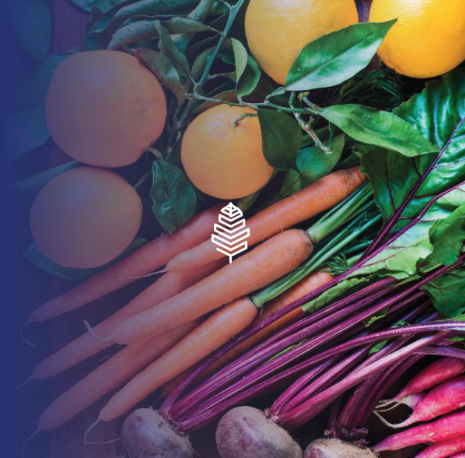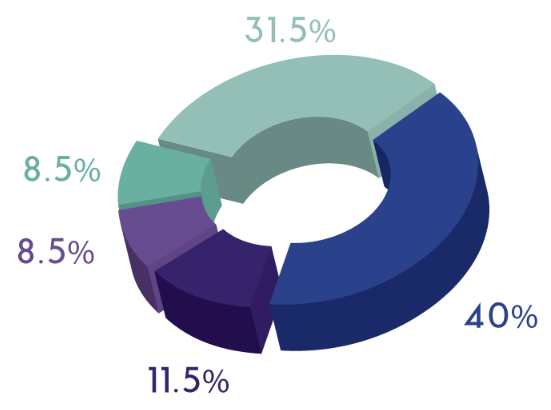
The rapid urbanization that is happening now goes hand in hand with the rapid increase in urban poverty and food insecurity.
By 2020, developing countries in Africa, Asia, and Latin America will be home to around 75% of city residents and eight of nine major cities which are estimated to have a population of more than 20 million. To manage agricultural supply chain products as they move, Value chain participants need a safe, transparent, trustworthy platform and market. Agro chain management builds networks among key stakeholders and improves delivery, while reducing costs and inefficiencies.
VFarm believes that urban vertical farming is the solution to the main problem above. The idea of building farms stacked vertically over skyscrapers that produce plants twice as fast, while using 40% less power, has 80% less food waste, and uses 99% less water than outdoor fields is definitely the way to front.
The vertical agricultural market was valued at USD 1.5 billion in 2016 and is expected to record a CAGR of 23.03% during the forecast period (2018-2023). Asia-Pacific is the largest and leading region in using vertical farming in the present, followed by Europe and North America. Although North America and Europe have a large proportion of livestock to use innovative technology in agriculture, the Asia-Pacific region has many investors who are interested in exploring opportunities for vertical farming, with increasing concerns about food security because of the population that continues to grow in the region. Lack of agricultural land, population growth, and demand for pesticide-free food are the main key drivers of the emergence of vertical agriculture.
The VFarm system is:
Proven and supported urban research technology licensed by Agrosky Sdn. Bhd. (ASSB), vertical agriculture specialist. This system provides a DLT blockchain layer that creates unchanged records for each batch of production allowing source verification, planting, packaging and distribution.
This in turn allows ecosystem users not only to have total product traceability on food security but also to encourage social impact through a choice of information about their purchases.
The VFarm economic model is based on a Social Company (SE) in line with the United Nations Sustainable Development Goals (SDG). SE is the future of development because it is able to solve several development problems that cannot be resolved by donors or the government. This is innovation that involves behavior change and therefore needs to utilize all the energy in the Base of Population (BOP).
VFarm believes that community-based ecosystems that encourage entrepreneurship, driven by high-quality content and rewards and hosted on blockchain-based platforms are the solution. Although vertical farming can never be expected to replace traditional agriculture, it is possible that they must complement each other to meet food demand in future.
This makes economic sense, is environmentally friendly, understands technology, and most importantly, is sensitive to health. Vertical farming is no longer a fairy tale, now it's happening!
Urban food market infrastructure and services

To achieve cost-effective food marketing, minimize postharvest losses, reduce health risks and ensure the stability of staple food supplies to cities, efficient market infrastructure such as assembly, wholesale and retail markets, storage facilities, as well as basic handling and transportation facilities and services, very important. Market infrastructure, facilities and services, equipped with new technologies, such as logistics and storage systems and cooled information that tracks inventory, must be planned at the regional, metropolitan, and urban levels.
These factors include:market failure;
less developed urban food systems;
absence of market transparency;
lack of economies of scale along the distribution system; and
high transportation costs and high physical losses at all levels of distribution
The growth of urban populations, changing consumer perceptions of food safety and quality, together with increases in urban income and purchasing power, has caused a shift from consumption of staple carbohydrates and processed foods, to demand for higher, fresher and minimal values. preserved foods (especially fruits and vegetables) that are considered to be nutritionally superior. These provide opportunities to improve the supply chain for fresh products, ensure higher quality and safety for consumers, and better returns for producers. Most of the fresh food consumed by urban consumers comes from rural areas, and along with the development of the city, as well as the length of the rural-urban supply chain.
VFARM Token
VFT Token
The VFarm (VFT) utility token is fully compliant with ERC20 and is available for swaps with BTC and ETH. The price of the basic token at the time of the crowswap launch is set at USD $ 0.10.
Use of Tokens
Any use of tokens imagined by this White Book will only be used as a reward for products or services on the VFarm plate (subject to availability according to VFarm policy) and there are no other functions or rights attached to the token.
Intellectual property rightsBrand and domain names
Source code
Database
Process
Algorithm
Why Fund With Crowdswap Tokens
Our goal for VFarm is to enable easy and fast access to production and services while providing users the power to create social impacts through their choice of actions. VFarm also aims to create a fair ecosystem for farmers that can be achieved with results-based contributions. This cannot be done without crypto utility and blockchain tokens.
Hardcap
Hardcap for VFarm ICO is USD $ 10 million.
Issuance of Tokens
VFarm (VFT) tokens will be issued immediately at the end of each crowswap stage.
Published Token Distribution
A total of 375,000,000 VFARM (VFT) will be generated. All tokens held by the founder, project team and advisory panel will be reversed for 12 months with a monthly vesting window.
Tokens that are not exchanged at the end of the ICO period will be placed under the reserve for ecosystem operations:40%: for BTC or ETH to fund development & operations
17%: will be saved as a reserve for ecosystem operations
15%: will be saved as a reserve for future expansion
10%: will be held by the founder and members of the project team
5%: will be used for marketing
5%: will be held by our ICO advisor
3%: will be used for prizes during the ICO period
2.5%: will be held by the advisory panelist
2.5%: will be used in social accountability programs
Bonus
The Pre-ICO stage will be carried out with a 30% bonus for exchanging a minimum of 10,000 tokens.
Usage Distribution
Of the USD $ 10 million associated with this ICO exercise, the following is the distribution of usage:
40% of the contribution will be used for the construction of the VFarm System in Kuala Lumpur.
31.5% will be used for the development of Blockchain Agro Traceability.
11.5% will be used for IoT R & D Systems.
8.5% will be used for the Irrigation System R & D.
8.5% will be used for site rental fees.

Token Sales Information
Public Sale Starts: TBD
Public Sale Ends: TBD
Total Token Supply: 375,000,000
Token Symbol: VFT
Hard Cap: USD $10m
Base Token Price: USD $0.10
Accepted: ETH, BTC, XRP, LTC
Roadmap
2019
Q1
Concept paper
Commercial paper
Establishment of Partner Collaboration
Q2
Beginning of Ladang 1 Construction (Kuala Lumpur)
Development of White Paper
Blockchain and IoT Development
Proof Of Work (POW), Tokenomic
Construction & Harvest Settlement
ICO Start
Q3
ICO Ends
Commencement of Contract Agriculture
Start of R & D on Agro Traceability
Blockchain Development
Commencement of R & D in the Irrigation System
Commencement of R & D on IoT
Q4
Physical Agriculture Development (POC)
Beginning of construction of Fields 2,3 & 4 (Kuala Lumpur)
Construction & Harvest Settlement
Commencement of Agriculture Contract
2020
Q1
Expansion to the London market
Start of construction of Farm 1 (London)
Construction & Harvest Settlement
Commencement of Commercialization to consumers
Q2
Commencement of a VFarm / franchise license
Construction of Farm 5, 6 & 7 (Kuala Lumpur)
Construction & Harvest Settlement
Commencement of Agriculture Contract
Q3
Construction of Farm 2 starts, (London)
Construction of Farm 8, 9 & 10 (Kuala Lumpur) began
Construction & Harvest Settlement
Q4
Commencement of Commercialization for Consumers
Commencement of Agriculture Contract
2021
Q1
Start of construction of Farm 11 (Kuala Lumpur)
Construction of Farm 3 & 4 (London)
Construction & Harvest Settlement
Commencement of Commercialization for Consumers
If you want to know more about the VFarm project you can visit the link below, Enough for my writing this time which only discusses some important points of this project, for more information please visit the link below
Website: https://vfarm.global
Whitepaper: https://vfarm.global/whitepaper.pdf
Twitter: https://twitter.com/vf4rm
Telegram: https://t.me/Vfarmofficial
Facebook: https://www.facebook.com/vf4rmcommunity
Github: https://github.com/vfarm
Medium: https://medium.com/vfarmofficial
Instagram: https://www.instagram.com/vf4rm
AUTHOR
Username : erwin_ibrahim
Email : erwinrohadi87@gmail.com
Ethereum : 0x347A7A7dB223A23774375EFfB6b6e96c5Ac64C1c


0 Comments